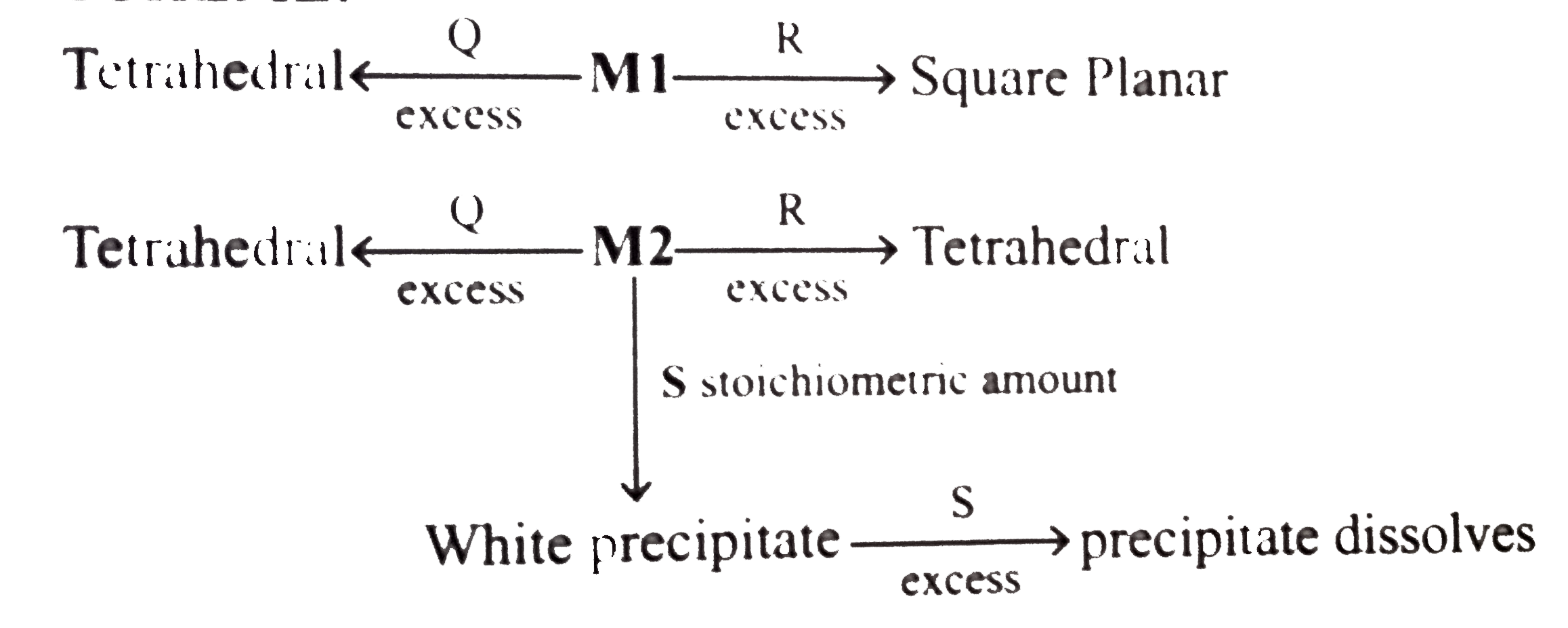An aqueous solution of a metal ion (A) on reaction with Kl gives a black brownish ppt (B) and this aqueous suspension on treatment with excess Kl gives orange yellowish solution. Then A is
pb2+
Bl3+
Hg2+2
Hg2+
The correct Answer is:B
To solve the question step by step, we need to identify the metal ion (A) based on the reactions described.
Step 1: Analyze the Reaction with KI
We start with an aqueous solution of a metal ion (A) that reacts with potassium iodide (KI) to produce a blackish-brown precipitate (B).
Hint: Think about common metal ions that form colored precipitates with iodide ions.
Step 2: Identify Possible Metal Ions
Let's consider some metal ions that could react with KI:
- Lead (Pb²⁺): Forms a yellow precipitate (PbI₂).
- Bismuth (Bi³⁺): Forms a blackish-brown precipitate (BiI₃).
- Mercurous (Hg₂²⁺): Forms a yellow precipitate (HgI).
- Mercuric (Hg²⁺): Forms a scarlet red precipitate (HgI₂).
Hint: Focus on the color of the precipitate formed. We are looking for a blackish-brown precipitate.
Step 3: Evaluate the Precipitate Color
From the options:
- Pb²⁺ gives a yellow precipitate, which does not match.
- Bi³⁺ gives a blackish-brown precipitate, which matches.
- Hg₂²⁺ gives a yellow precipitate, which does not match.
- Hg²⁺ gives a scarlet red precipitate, which does not match.
Hint: Eliminate options that do not produce a blackish-brown precipitate.
Step 4: Reaction with Excess KI
Next, we consider the reaction of the precipitate (B) with excess KI. The blackish-brown precipitate (BiI₃) formed from bismuth will react with excess KI to form a soluble complex, BiI₄⁻, which is known to give an orange-yellow solution.
Hint: Understand the concept of complexation and how excess reagents can change the solubility and color of precipitates.
Step 5: Confirm the Identity of A
Since Bi³⁺ produces a blackish-brown precipitate (BiI₃) and forms an orange-yellow solution (BiI₄⁻) upon treatment with excess KI, we can conclude that the metal ion (A) is indeed bismuth (Bi³⁺).
Final Conclusion: The metal ion (A) is Bismuth (Bi³⁺).
Summary
- Aqueous solution of metal ion A reacts with KI to form a blackish-brown precipitate (B).
- Upon treatment with excess KI, the precipitate forms an orange-yellow solution.
- The correct identification of A is Bismuth (Bi³⁺).
We start with an aqueous solution of a metal ion (A) that reacts with potassium iodide (KI) to produce a blackish-brown precipitate (B).
Let's consider some metal ions that could react with KI:
- Lead (Pb²⁺): Forms a yellow precipitate (PbI₂).
- Bismuth (Bi³⁺): Forms a blackish-brown precipitate (BiI₃).
- Mercurous (Hg₂²⁺): Forms a yellow precipitate (HgI).
- Mercuric (Hg²⁺): Forms a scarlet red precipitate (HgI₂).
From the options:
- Pb²⁺ gives a yellow precipitate, which does not match.
- Bi³⁺ gives a blackish-brown precipitate, which matches.
- Hg₂²⁺ gives a yellow precipitate, which does not match.
- Hg²⁺ gives a scarlet red precipitate, which does not match.
Next, we consider the reaction of the precipitate (B) with excess KI. The blackish-brown precipitate (BiI₃) formed from bismuth will react with excess KI to form a soluble complex, BiI₄⁻, which is known to give an orange-yellow solution.
Since Bi³⁺ produces a blackish-brown precipitate (BiI₃) and forms an orange-yellow solution (BiI₄⁻) upon treatment with excess KI, we can conclude that the metal ion (A) is indeed bismuth (Bi³⁺).
- Aqueous solution of metal ion A reacts with KI to form a blackish-brown precipitate (B).
- Upon treatment with excess KI, the precipitate forms an orange-yellow solution.
- The correct identification of A is Bismuth (Bi³⁺).
Similar Questions
Aqueous solution of Na2S2O3 on reaction with CI2, gives
View SolutionAn aqueous solution containing S−2 ions will not give
View SolutionAn aqueous solution containing S2− ions will not give:
View SolutionAqueous hypo solution on reaction with aqueous AgNO3 gives :
View SolutionAqueous solution of BaBr2 , gives yellow ppt with
View SolutionAqueous solution of sodium succinate on electrolysis gives mainly
View SolutionAqueous Solution of BaBr2 gives yellow precipitate with:
View SolutionA metal nitrate reacts with KI to give a black precipitate which on addition of excess of Kl is converted into orange colour solution.The cation of the metal nitrate is :
View SolutionWhich ion will give colour in the aqueous solution ?
View SolutionAn aqueous solution of metal ion MI reacts separately with reagents Q and R in excess to give tetrahedral and square planar complexes, respectively An aqueous solution of another metal ion M2 always forms tetrahedral complexs with theses reagents. Aqueous solution of M2 on reaction with reagent S gives white precipitate which dissolves in excess of S The reactions are summarised in the scheme given below: SCHEME :

What is M2
View Solution

